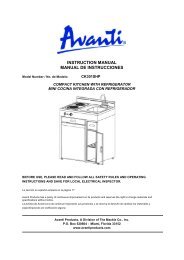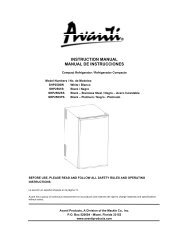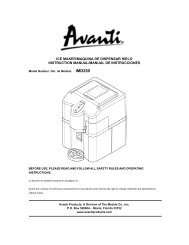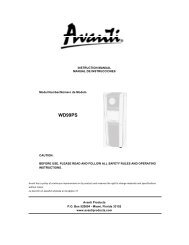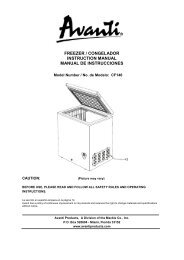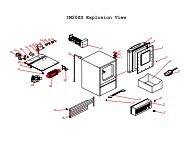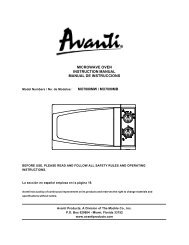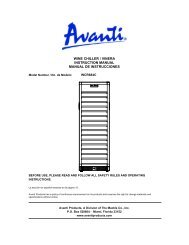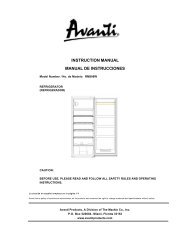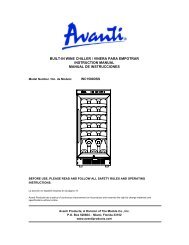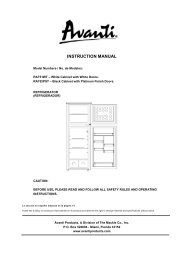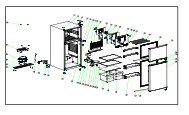FREEZER/CONGELADOR INSTRUCTION ... - Avanti Products
FREEZER/CONGELADOR INSTRUCTION ... - Avanti Products
FREEZER/CONGELADOR INSTRUCTION ... - Avanti Products
You also want an ePaper? Increase the reach of your titles
YUMPU automatically turns print PDFs into web optimized ePapers that Google loves.
<strong>FREEZER</strong>/<strong>CONGELADOR</strong><br />
<strong>INSTRUCTION</strong> MANUAL/MANUAL DE INSTRUCCIONES<br />
Model Number/Número de Modelo:<br />
CF211G<br />
BEFORE USE, PLEASE READ AND FOLLOW ALL SAFETY RULES AND OPERATING<br />
<strong>INSTRUCTION</strong>S.<br />
La sección en español empieza en la página 16.<br />
<strong>Avanti</strong> has a policy of continuous improvement on its products and reserves the right to change materials and<br />
specifications without notice.<br />
<strong>Avanti</strong> <strong>Products</strong>, A Division of The Mackle Co., Inc.<br />
P.O. Box 520604 - Miami, Florida 33152<br />
www.avantiproducts.com<br />
1
TABLE OF CONTENTS<br />
Chest Freezer Safety 3<br />
Important Safeguides 4<br />
Help Us Help You 5<br />
Parts and Features 6<br />
Important Safety Instructions 7<br />
Installation Instructions 7<br />
Before Using Your Appliance 7<br />
Installation of Your Appliance 7<br />
Electrical Connection 8<br />
Operating Your Appliance 9<br />
Temperature Control 9<br />
Temperature Control Panel Cover 9<br />
Defrosting Your Appliance 10<br />
The Freezer Compartment 10<br />
Door Lock 10<br />
Care and Maintenance 11<br />
Cleaning Your Appliance 11<br />
Maintenance of Your Appliance 11<br />
Energy Saving Tips 11<br />
Troubleshooting Guide 12 – 13<br />
Service for Your Appliance 14<br />
Wiring Diagram 14<br />
Your <strong>Avanti</strong> <strong>Products</strong> Warranty 15<br />
Instrucciones en Español 16-22<br />
Registration Information and Registration Card 23<br />
2
CHEST <strong>FREEZER</strong> SAFETY<br />
Your safety and the safety of others are very important.<br />
We have provided many important safety messages in this manual and on your appliance. Always<br />
read and obey all safety messages.<br />
This is the Safety Alert Symbol. This symbol alerts you to potential hazards that<br />
can kill or injure you and others. All safety messages will follow the Safety<br />
Alert Symbol and either the wards” DANGER”, “WARNING” or “CAUTION”.<br />
Danger means that failure to heed this safety<br />
statement may result in severe personal<br />
injury or death.<br />
Warning means that failure to heed this<br />
safety statement may result in extensive<br />
product damage, serious personal injury, or<br />
death.<br />
Caution means that failure to heed this<br />
safety statement may result in minor or<br />
moderate personal injury, or property or<br />
equipment damage.<br />
All safety messages will alert you to what the potential hazard is, tell you how to reduce the chance of<br />
injury, and let you know what can happen if the instructions are not followed.<br />
3
IMPORTANT SAFEGUARDS<br />
Before the chest freezer is used, it must be properly positioned and installed as<br />
described in this manual, so read the manual carefully. To reduce the risk of fire,<br />
electrical shock or injury when using the chest freezer, follow basic precautions,<br />
including the following:<br />
• Plug into a grounded 3-prong outlet, do not remove grounding prong, do not use an adapter, and do<br />
not use an extension cord<br />
• Replace all panels before operating<br />
• It is recommended that a separate circuit, serving only your chest freezer, be provided. Use receptacles<br />
that cannot be turned off by a switch or pull chain<br />
• Never clean chest freezer parts with flammable fluids. These fumes can create a fire hazard or<br />
explosion. And do not store or use gasoline or other flammable vapors and liquids in the vicinity of this<br />
or any other appliance. The fumes can create a fire hazard or explosion.<br />
• Before proceeding with cleaning and maintenance operations, make sure the power line of the unit is<br />
disconnected.<br />
• Do not connect or disconnect the electric plug when your hands are wet<br />
• Unplug the chest freezer or disconnect the power before cleaning or servicing. Failure to do so can<br />
result in electrical shock or death.<br />
• Do not attempt to repair or replace any part of your chest freezer unless it is specifically recommended<br />
in this material. All other servicing should be referred to a qualified technician.<br />
• Use two or more people to move and install the chest freezer. Failure to do so can result in back or<br />
other injury.<br />
• To ensure proper ventilation for your chest freezer, the unit must be completely unobstructed. Choose a<br />
well-ventilated area with temperatures above 55 0 F (13 0 C) and below 90 0 F (32 0 C). This unit must be<br />
installed in an area protected from the elements, such as wind, rain, water spray or sunlight.<br />
• The chest freezer should not be located next to ovens, grills or other sources of high heat.<br />
• The chest freezer must be installed with all electrical, water and drain connections in accordance with<br />
state and local codes. A standard electrical supply (115 V AC only, 60 Hz), properly grounded in<br />
accordance with the National Electrical Code and local codes and ordinances is required.<br />
• Do not kink or pinch the power supply cord of the chest freezer.<br />
• The fuse (or circuit breaker) size should be 15 amperes.<br />
• It is important for the chest freezer to be leveled in order to work properly. You may need to make<br />
several adjustments to level it.<br />
• All installation must be in accordance with local plumbing code requirements.<br />
• Make certain that the pipes are not pinched or kinked or damaged during installation.<br />
• Check for leaks after connection.<br />
• Never allow children to operate, play with or crawl inside the chest freezer<br />
• Do not use solvent-based cleaning agents or abrasives on the interior. These cleaners may damage or<br />
discolor the interior.<br />
• Do not use this apparatus for other than its intended purpose.<br />
4
HELP US HELP YOU...<br />
Read this guide carefully.<br />
It is intended to help you operate and maintain<br />
your new freezer properly.<br />
Keep it handy to answer your questions.<br />
If you don't understand something or you need<br />
more help, please call:<br />
<strong>Avanti</strong> Customer Service<br />
800-220-5570<br />
Keep proof of original purchase date (such as<br />
your sales slip) with this guide to establish the<br />
warranty period.<br />
CAUTION:<br />
THIS APPLIANCE IS NOT<br />
DESIGNED FOR THE STORAGE<br />
OF MEDICINE OR OTHER<br />
MEDICAL PRODUCTS.<br />
Write down the model and serial numbers.<br />
You'll find them on a plate located on the rear<br />
outside wall of the freezer.<br />
Please write these numbers here:<br />
_____________________________________<br />
Date of Purchase<br />
_____________________________________<br />
Model Number<br />
_____________________________________<br />
Serial Number<br />
Use these numbers in any correspondence or<br />
service calls concerning your freezer.<br />
If you received a damaged freezer, immediately<br />
contact the dealer (or builder) that sold you the<br />
freezer.<br />
Save time and money. Before you call for<br />
service, check the Troubleshooting Guide. It<br />
lists causes of minor operating problems that<br />
you can correct yourself.<br />
IF YOU NEED SERVICE<br />
We're proud of our service and want you to be<br />
pleased. If for some reason you are not happy<br />
with the service you receive, here are some<br />
steps to follow for further assistance.<br />
FIRST, contact the people who serviced your<br />
appliance. Explain why you are not pleased. In<br />
most cases, this will solve the problem.<br />
NEXT, if you are still not pleased, write all the<br />
details, including your telephone number, and<br />
send it to:<br />
Customer Service<br />
<strong>Avanti</strong> <strong>Products</strong><br />
10880 NW 30 Street<br />
Miami, FL 33172 USA<br />
5
PARTS AND FEATURES<br />
9<br />
1. SLIDING GLASS LIDS (TOTAL 2)<br />
2. DRAIN PLUG(not shown)<br />
3. CASTERS (TOTAL 2)<br />
4. LOCK ASSEMBLY<br />
5. CONTROL PANEL<br />
6. THERMOSTAT CONTROL KNOB<br />
7. POWER INDICATOR LIGHT<br />
8. COMPRESSOR ON INDICATOR LIGHT<br />
9. ROLLERS (TOTAL 2)<br />
6
IMPORTANT SAFETY <strong>INSTRUCTION</strong>S<br />
<br />
<br />
<br />
<br />
<br />
<br />
To reduce the risk of fire, electrical shock, or<br />
WARNING<br />
injury when using your freezer, follow these<br />
basic precautions:<br />
Read all instructions before using the freezer.<br />
DANGER or WARNING: Risk of child entrapment.<br />
Child entrapment and suffocation are not problems of the past. Junked or<br />
abandoned appliances are still dangerous, even if they will “just sit in the garage a<br />
few days.”<br />
Before you throw away your old freezer: Take off the doors. Leave the shelves in<br />
place so that children may not easily climb inside.<br />
Never allow children to operate, play with, or crawl inside the appliance.<br />
Never clean appliance parts with flammable fluids. The fumes can create a fire hazard<br />
or explosion.<br />
Do not store or use gasoline or any other flammable vapors and liquids in the vicinity of<br />
this or any other appliance. The fumes can create a fire hazard or explosion.<br />
-Save these instructions-<br />
INSTALLATION <strong>INSTRUCTION</strong>S<br />
Before Using Your Freezer<br />
· Remove the exterior and interior packing.<br />
· Check to be sure you have all of the following parts:<br />
• 3 Storage Baskets<br />
• 2 keys<br />
• 1 Instruction Manual<br />
• 1 Plastic Scraper<br />
· Before connecting the freezer to the power source, let it stand upright for approximately 2 hours.<br />
This will reduce the possibility of a malfunction in the cooling system from handling during<br />
transportation.<br />
· Clean the interior surface with lukewarm water using a soft cloth.<br />
Installation of Your Freezer<br />
· This appliance is designed to be free standing only, and should not be recessed or built-in.<br />
· Place your appliance on a floor that is strong enough to support the appliance when it is fully<br />
loaded.<br />
· Allow 5 inches of space between the back and sides of the appliance, which allows the proper air<br />
circulation to cool the compressor and condenser.<br />
· Locate the freezer away from direct sunlight and sources of heat (stove, heater, radiator, etc.).<br />
Direct sunlight may affect the acrylic coating and heat sources may increase electrical consumption.<br />
Extreme cold ambient temperatures may also cause the freezer not to perform properly.<br />
· Avoid locating the appliance in moist areas. Too much moisture in the air will cause frost to form<br />
quickly on the evaporator requiring more frequent defrosting of the freezer.<br />
· Plug the appliance into an exclusive properly installed grounded wall outlet. Do not under any<br />
circumstances cut or remove the third (ground) prong from the power cord. Any questions<br />
concerning power and or grounding should be directed toward a certified electrician or an authorized<br />
<strong>Avanti</strong> <strong>Products</strong> service center.<br />
· After plugging the appliance into a wall outlet, allow the unit to cool down for 2~3 hours before<br />
placing food in the freezer compartment.<br />
7
Electrical Connection<br />
Warning<br />
Improper use of the grounded plug can result in the risk of electrical shock. If the power<br />
cord is damaged, have it replaced by an authorized <strong>Avanti</strong> <strong>Products</strong> service center.<br />
This appliance should be properly grounded for your safety. The power cord of this appliance is equipped<br />
with a three-prong plug which mates with standard three prong wall outlets to minimize the possibility of<br />
electrical shock.<br />
Do not under any circumstances cut or remove the third ground prong from the power cord supplied.<br />
This freezer requires a standard 115Volts~/60Hz electrical outlet with three-prong ground.<br />
The cord should be secured behind the freezer and not left exposed or dangling to prevent accidental<br />
injury.<br />
Never unplug the freezer by pulling the power cord. Always grip the plug firmly and pull straight out from<br />
the receptacle.<br />
Do not use an extension cord with this freezer. If the power cord is too short, have a qualified electrician<br />
or service technician install an outlet near the freezer.<br />
The “POWER” light indicates that the freezer is properly connected to the electrical power. The light<br />
indicates power supply, and will glow even if the temperature control dial is turned to “OFF”, or the<br />
compressor has failed to work and the compartment is not being cooled.<br />
‣ Extension Cord<br />
Because of potential safety hazards under certain conditions, it is strongly recommended that you do not<br />
use an extension cord with this unit. However, if you must use an extension cord it is absolutely<br />
necessary that it be a UL/CUL-Listed, 3-wire grounding type appliance extension cord having a grounding<br />
type plug and outlet and that the electrical rating of the cord be 115 volts and at least 10 amperes.<br />
‣ SURGE PROTECTOR<br />
Most electrical appliances use a series of electric control boards to operate. These boards are very<br />
susceptible to power surges and could be damaged or destroyed.<br />
If the appliance is going to be used in an area or if your city / country is prone to power surges / outages;<br />
it is suggested that you use a power surge protector for all electrical devices / appliances you use. The<br />
surge protector that you select must have a surge block high enough to protect the appliance it is<br />
connected to. If you have any questions regarding the type and size of surge protector needed contact a<br />
licensed electrician in your area.<br />
Damages due to power surges are not considered a manufacturer covered defect and will void your<br />
product warranty.<br />
8
OPERATING YOUR <strong>FREEZER</strong><br />
Temperature Control<br />
Your freezer has one control for regulating the temperature. The temperature control is located on<br />
the lower right hand corner.<br />
The first time you turn the unit on, turn the temperature control knob in a clockwise direction to<br />
the maximum setting "7" and run for at least 2 hours before putting frozen foods inside.<br />
This will ensure the cabinet is thoroughly chilled before food is put in.<br />
The range of the temperature control is from position "1" the warmest to "7" the coldest. Adjust<br />
the temperature control to the setting that best suits your needs. The setting of “4” should be<br />
correct for home or office freezer use.<br />
To turn the freezer off, turn the temperature control to "OFF".<br />
NOTE:<br />
• Turning the temperature control to "OFF" position stops the cooling cycle but does not shut off the<br />
power to the freezer.<br />
• If the unit is unplugged, lost power, or turned off; you must wait 3 to 5 minutes before restarting<br />
the unit. If you attempt to restart before this time delay, the freezer will not start.<br />
• Large amounts of food will lower the cooling efficiency of the appliance.<br />
• If you choose to change the thermostat setting, adjust thermostat control by one numerical<br />
increment at a time. Allow several hours for temperature to stabilize between adjustments.<br />
9
Defrosting Your Freezer<br />
When? For the most efficient operation and minimum energy consumption, defrost the freezer<br />
when the frost on the freezer walls is excessive or ¼ to ½ inch thick.<br />
Choose a time when the stock of frozen food is low.<br />
CAUTION<br />
Do not use boiling water because it may damage the plastic parts. In addition, never use a sharp<br />
or metallic instrument to remove frost as it may damage the cooling coils and will void the<br />
warranty. We recommend using the plastic scraper provided with your unit.<br />
<br />
<br />
<br />
<br />
<br />
<br />
<br />
<br />
<br />
<br />
<br />
<br />
<br />
Remove the frozen food from the freezer and place it in a cooler to protect the food.<br />
Turn the thermostat knob to “OFF”.<br />
Unplug the freezer.. The Power Supply light should be OFF.<br />
During the defrost process, the ice melts into the cabinet.<br />
Remove the drain plug on the inside floor of the freezer by screwing out.<br />
Place a shallow pan outside drain outlet. The defrost water will drain out.<br />
Check the pan occasionally so the water does not overflow.<br />
Clean the interior of the freezer.<br />
Replace the plug on the inside floor, The Power Supply light should be ON.<br />
Reset the thermostat to desired setting.<br />
Allow the cabinet to cool for one hour.<br />
Turn the temperature control knob in a clockwise direction to the maximum position “7” for a<br />
minimum of 2 hours.<br />
Return food to the freezer.<br />
HELPFUL HINT:<br />
Defrosting usually takes a few hours. Leaving the door open will help speed the process. Also,<br />
pouring warm water (not boiling) on the ice/frost will help speed melting. If you must use a<br />
scraper- please use caution - it is very easy to damage the freezer compartment and void your<br />
warranty.<br />
The Freezer Compartment<br />
This compartment is designed for the long term storage of frozen food. Storage time is up to<br />
three months.<br />
The storage life of frozen foods varies and the recommended storage time should not be<br />
exceeded. The instructions regarding the care of frozen foods should be followed when<br />
defrosting the freezer.<br />
Pre-packed commercially frozen food should be stored in accordance with the frozen foods<br />
manufacturer’s instructions for a three star frozen food storage compartment or home freezer.<br />
Place frozen food into the freezer as quickly as possible after purchase. If there are instructions<br />
on the packet, carefully follow these instructions regarding storage times.<br />
The freezer door is susceptible to breaking due to excessive ice build up. Be sure to defrost<br />
when the ice reaches ¼ to ½ inch thick.<br />
Storage baskets are provided for the organization of odd-shaped items. To reach other packages<br />
in the freezer, just slide the baskets to one side, or lift it out.<br />
Door Lock<br />
Your unit is provided with a lock and key combination. The keys are located inside the plastic bag that<br />
contains the User's Guide. Insert the key into the lock and turn it clockwise to unlock the door. To lock<br />
the door do the reverse operation making sure metal pin is engaged completely. Remove the key and<br />
place it in a secure place for safekeeping.<br />
10
CARE AND MAINTENANCE<br />
Cleaning Your Freezer<br />
Upon installation of your new appliance, it is recommended that it be cleaned thoroughly.<br />
Turn the temperature control to "OFF", unplug the freezer, remove the food and storage baskets.<br />
Wash the inside with a damp warm cloth containing a water and baking soda solution. The<br />
solution should be about 2 tablespoons of baking soda to a quart of water.<br />
Wash the storage baskets with a mild detergent solution.<br />
Be sure to keep the door gasket (seal) clean to keep the unit running efficiently.<br />
The outside of the freezer should be cleaned with mild detergent and warm water.<br />
Dry the interior and exterior with a soft cloth.<br />
The condenser coils should be vacuumed when they are dusty or dirty.<br />
It is recommended that the unit be cleaned each time it is defrosted to help keep the unit odor<br />
free and running efficiently.<br />
Vacation Time<br />
Use extreme caution in the case of children. The unit should not be accessible to child’s play.<br />
Short vacations: Leave the freezer operating during vacations of less than three weeks.<br />
Long vacations: If the appliance will not be used for several months, remove all food and unplug<br />
the power cord. Clean and dry the interior thoroughly. To prevent odor and mold growth, leave<br />
the door open slightly: blocking it open if necessary or have the door removed.<br />
Moving Your Freezer<br />
Remove all the food.<br />
Securely tape down all loose items inside your freezer.<br />
Remove the rollers to prevent damage<br />
Tape the doors shut.<br />
Be sure the freezer stays in the upright position during transportation.<br />
Energy Saving Tips<br />
The freezer should be located in the coolest area of the room, away from heat producing<br />
appliances or heating ducts, and out of the direct sunlight.<br />
Let hot foods cool to room temperature before placing in the freezer. Overloading the freezer<br />
forces the compressor to run longer. Foods that freeze too slowly may lose quality, or spoil.<br />
Be sure to wrap foods properly, and wipe containers dry before placing them in the freezer. This<br />
cuts down on frost build-up inside the freezer.<br />
Freezer storage bin should not be lined with aluminum foil, wax paper, or paper toweling. Liners<br />
interfere with cold air circulation, making the freezer less efficient.<br />
Organize and label food to reduce door openings and extended searches. Remove as many<br />
items as needed at one time, and close the door as soon as possible.<br />
11
PROBLEMS WITH YOUR <strong>FREEZER</strong> ?<br />
You can solve many common freezer problems easily, saving you the cost of a possible service call. Try<br />
the suggestions below to see if you can solve the problem before calling the servicer.<br />
TROUBLESHOOTING GUIDE<br />
PROBLEM<br />
Freezer does not operate.<br />
Compressor turns on and off frequently.<br />
Temperature inside the freezer is too warm.<br />
Temperature inside the freezer is too cold.<br />
Temperature of external freezer surface is warm.<br />
Popping or cracking sound when compressor<br />
comes on.<br />
Bubbling or gurgling sound, like water boiling.<br />
POSSIBLE CAUSE<br />
Not plugged in.<br />
The circuit breaker tripped or blown fuse.<br />
The freezer temperature control is set at "OFF".<br />
The room temperature is hotter than normal.<br />
A large amount of food has been added to the<br />
freezer.<br />
The door is opened too often.<br />
The door is not closed completely.<br />
The temperature control is not set correctly.<br />
The door gasket does not seal properly.<br />
The freezer does not have the correct<br />
clearances.<br />
The freezer has recently been disconnected for a<br />
period of time. Four hours are required for the<br />
freezer to cool down completely.<br />
Temperature control is set too warm. Turn the<br />
control to a cooler setting and allow several hours<br />
for the temperature to stabilize.<br />
Door is kept open too long or is opened too<br />
frequently. Warm air enters the freezer every<br />
time the door is opened. Open the door less<br />
often.<br />
The door is not closed completely.<br />
The door gasket does not seal properly.<br />
A large amount of warm or hot food might have<br />
been stored recently. Wait until the freezer has<br />
had a chance to reach its selected temperature.<br />
The freezer has recently been disconnected for a<br />
period of time. Four hours are required for the<br />
freezer to cool down completely.<br />
Temperature control is set too cold. Turn the<br />
control to a warmer setting and allow several<br />
hours for the temperature to stabilize.<br />
Switch on the "7", This causes continuous<br />
running of the compressor and bypasses the<br />
temperature control.<br />
The exterior freezer walls can be as much as<br />
30 F warmer than room temperature. This is<br />
normal while the compressor works to transfer<br />
heat from inside the freezer cabinet.<br />
Metal parts undergo expansion and contraction,<br />
as in hot water pipes. This is normal. Sound will<br />
level off or disappear as freezer continues to run.<br />
Refrigerant (used to cool freezer) is circulating<br />
throughout the system. This is normal.<br />
12
Vibrations.<br />
Moisture forms on inside freezer walls.<br />
Moisture forms on outside of freezer.<br />
The door will not close properly.<br />
Check to assure that the freezer is not on a level<br />
surface.<br />
Floor is uneven or weak. Freezer rocks on the<br />
floor when it is moved slightly. Be sure floor can<br />
adequately support freezer. Level the freezer by<br />
putting wood or metal shims under part of the<br />
freezer.<br />
The freezer is touching the wall. Re-level the<br />
freezer and move it from the wall.<br />
See “Installation Instructions”<br />
Weather is hot and humid, which increases<br />
internal rate of frost build-up. This is normal.<br />
Door is slightly open.<br />
Door is kept open too long, or is opened too<br />
frequently. Open the door less often.<br />
The door is not sealed properly.<br />
Door is slightly open, causing cold air from inside<br />
the freezer to meet warm moist air from outside.<br />
The freezer is not on a level surface.<br />
The gasket is dirty.<br />
The storage baskets are out of position.<br />
13
SERVICE FOR YOUR <strong>FREEZER</strong><br />
We are proud of our customer service organization and the network of professional service technicians<br />
that provide service on your <strong>Avanti</strong> appliances. With the purchase of your <strong>Avanti</strong> freezer, you can have<br />
the confidence that if you ever need additional information or assistance the <strong>Avanti</strong> <strong>Products</strong> Customer<br />
Service team will be here for you. Just call us toll-free.<br />
Product Information<br />
800-323 5029<br />
Part Orders<br />
800-220 5570<br />
In-Home Repair Service<br />
800-220 5570<br />
AVANTI PRODUCTS CUSTOMER SERVICES<br />
Whatever your questions are about our products,<br />
help is available.<br />
You may order parts and accessories that will be<br />
delivered directly to your home.<br />
You may order these items by personal check,<br />
money order, Master Card, or Visa.<br />
An <strong>Avanti</strong> <strong>Products</strong> authorized service center will<br />
provide expert repair service, scheduled at a time<br />
that is convenient for you. Our trained servicers<br />
know your freezer inside and out.<br />
WIRING DIAGRAM<br />
14
YOUR <strong>Avanti</strong> <strong>Products</strong> WARRANTY<br />
WHAT IS COVERED<br />
LIMITED ONE-YEAR<br />
WARRANTY<br />
For one year from the date of purchase<br />
by the original owner, <strong>Avanti</strong> <strong>Products</strong><br />
will, at its option, repair or replace any<br />
part of the freezer, which proves to be<br />
defective in material or workmanship<br />
under normal use. During this period<br />
<strong>Avanti</strong> <strong>Products</strong> will provide all parts and<br />
labor necessary to correct such defects<br />
free of charge, so long as the appliance<br />
has been installed and operated in<br />
accordance with the written instructions<br />
in this manual. <strong>Avanti</strong> <strong>Products</strong> will<br />
provide you with a reasonably similar<br />
replacement product that is either new<br />
or factory refurbished. In rental or<br />
commercial use, the warranty period is<br />
90 days. All <strong>Avanti</strong> Appliances of 3.5<br />
cubic feet capacity or less must be<br />
brought/sent to the appliance service<br />
shop for repair.<br />
Staple your sales receipt here. Proof of<br />
original purchase date is needed to obtain<br />
service under warranty.<br />
LIMITED SECOND THROUGH<br />
FIFTH YEAR WARRANTY<br />
For the second through the fifth year from date<br />
of original purchase, <strong>Avanti</strong> <strong>Products</strong> will provide<br />
a replacement compressor free of charge due to<br />
a failure. You are responsible for the service<br />
labor and freight charges. In rental or<br />
commercial use, the limited compressor<br />
warranty is one year and nine months. Cost to<br />
move the appliance to the servicers’ shop and<br />
back to the user's home, as may be required,<br />
are the user's responsibility.<br />
<br />
<br />
<br />
<br />
<br />
<br />
<br />
<br />
<br />
Content losses of food due to spoilage.<br />
Incidental or consequential damages.<br />
Parts and labor costs for the following will<br />
not be considered as warranty:<br />
Chest freezer lid liners.<br />
Light bulbs and/or plastic housing.<br />
Plastic cabinet liners.<br />
Punctured evaporator that voids the<br />
warranty on the complete sealed system.<br />
Shipping and handling costs associated with<br />
the replacement of the unit.<br />
Repairs performed by unauthorized<br />
servicers.<br />
WHAT IS NOT COVERED<br />
<br />
<br />
<br />
<br />
<br />
<br />
Service calls that do not involve defects in<br />
material or workmanship such as customer<br />
education, or proper installation.<br />
Service calls that are related to external<br />
problems, such as abuse, misuse,<br />
inadequate electrical power, accidents, fire,<br />
floods, or acts of God.<br />
Surcharges including, but not limited to, any<br />
after hour, weekend, or holiday service calls,<br />
tolls, ferry trip charges, or mileage expense<br />
for service calls to remote areas, including<br />
the State of Alaska.<br />
Replacement of house fuses or resetting<br />
circuit breakers.<br />
Failure of the product if it is used for other<br />
than its intended purpose.<br />
This warranty does not apply outside the<br />
Continental USA.<br />
15
INSTRUCCIONES EN ESPAÑOL<br />
<br />
<br />
<br />
<br />
<br />
<br />
<br />
PRECAUCION<br />
Para reducir el riesgo de incendio, descarga<br />
eléctrica, o daño cuando use su<br />
electrodoméstico, siga las siguientes<br />
precauciones.<br />
Lea todas las instrucciones antes de usar su electrodoméstico.<br />
Peligro o Precaución: Existe el riesgo que los niños queden atrapados.<br />
Niños atrapados o sofocamiento no son un problema del pasado. Los electrodomésticos<br />
son peligrosos aún si sólo los deja en el garaje por un par de días.<br />
Antes de desechar su congelador o refrigerador usado: quítele las puertas. Deje las<br />
repisas en su lugar para evitar que los niños se queden atrapados.<br />
No permita que los niños manejen, jueguen o entren dentro del electrodoméstico.<br />
No limpie su electrodoméstico con líquidos inflamables. Los gases pueden ocasionar<br />
fuego o una explosión.<br />
No guarde ni use gasolina u otros líquidos inflamables cerca de este o de cualquier otro<br />
electrodoméstico. Los vapores pueden ocasionar fuego o explosión.<br />
- Guarde estas instrucciones.-<br />
INSTRUCCIONES PARA LA INSTALACION<br />
‣ Antes de Usar su Artefacto<br />
Retire la envoltura interna y externa.<br />
Verifique que tenga las siguientes partes: 3 canastas de almacenaje, un manual de<br />
instrucciones, y una espátula de plástico y 2 llaves<br />
Antes de conectar su electrodoméstico a la corriente eléctrica, ubíquelo en una superficie plana<br />
por lo menos por 2 horas. Esto reducirá la posibilidad de malfuncionamiento en el sistema de<br />
enfriamiento por la manipulación durante el transporte.<br />
Limpie la superficie interior con agua tibia usando un paño suave.<br />
‣ Instalación de su Congelador<br />
Ubique su congelador en un piso que sea lo suficientemente fuerte para soportar su peso cuando<br />
esté totalmente lleno o cargado.<br />
Deje aproximadamente 5 pulgadas de espacio entre la parte trasera y los costados de su<br />
electrodoméstico, así permitirá la circulación de aire necesaria para enfriar el compresor.<br />
Mantenga su congelador alejado del aire caliente, vapor o líquidos que puedan salpicarlo, ya que la<br />
unidad podría averiarse.<br />
Los rayos solares directos pueden dañar la capa acrílica, y las fuentes de calor pueden ocasionar un<br />
aumento en el consumo eléctrico. Manténgalo lo más alejado posible del agua para prevenir algún<br />
choque eléctrico. Evite los sitios húmedos y los ambientes extremadamente fríos ya que esto puede<br />
afectar la eficiencia del enfriamiento de su congelador.<br />
Evite ubicar su congelador en áreas mojadas o muy húmedas. Mucha humedad en el aire puede<br />
causar la formación de escarcha rapidamente y necesitará descongelar su congelador más<br />
frecuentemente.<br />
Conecte el congelador a un enchufe de pared exclusivo e instale el cable de tierra. Bajo ninguna<br />
razón se debe retirar la tercera punta del enchufe. Cualquier consulta con respecto a la energía y/o<br />
cable de tierra debe ser dirigida a un electricista certificado o autorizado por el Servicio Técnico de<br />
<strong>Avanti</strong> <strong>Products</strong>.<br />
16
Conexión Eléctrica<br />
ADVERTENCIA<br />
EL USO INAPROPIADO DEL ENCHUFE A TIERRA PUEDE OCASIONAR RIESGO DE UN<br />
CHOQUE ELECTRICO. SI EL CORDON SE DAÑASE, LLEVELO A UN CENTRO DE<br />
SERVICIO AUTORIZADO POR AVANTI PRODUCTS PARA QUE SE REEMPLACE.<br />
<br />
<br />
<br />
<br />
<br />
<br />
<br />
Para su seguridad, esta máquina de hacer hielo debe estar apropiadamente conectada a tierra. El cordón<br />
eléctrico de esta máquina de hacer hielo esta equipado con un enchufe de tres puntas, el cual encaja<br />
perfectamente en los receptáculos/enchufes de pared de tres puntas estándar, para minimizar la posibilidad de<br />
un choque eléctrico.<br />
Bajo ninguna circunstancia corte o retire la tercera punta (cable a tierra) del enchufe del cordón<br />
eléctrico.<br />
Nunca use un cable de extensión para conectar la unidad a la electricidad.<br />
Nunca use un adaptado con enchufe de solo 2 puntas.<br />
Si solo puede conectar la máquina de hacer hielo a un receptáculo/enchufe de pared de 2 puntas,<br />
comuníquese con un electricista calificado para que reemplace ese receptáculo/enchufe de pared<br />
por uno de 3 puntas, de acuerdo con los códigos de electricidad aplicables.<br />
Esta máquina de hacer hielo requiere un receptáculo/enchufe de pared de tres puntas estándar de<br />
115/120 voltios a.c.~/60hz.<br />
Para prevenir cualquier daño físico o lesión, el cordón debe ser asegurado detrás de la máquina de<br />
hacer hielo y no estar expuesto o colgando.<br />
Cable de Extensión<br />
Debido al posible riesgo de seguridad causado bajo ciertas circunstancias, se recomienda firmemente<br />
que no use un cable de extensión para este electrodoméstico. Sin embargo, si no tiene otra opción mas<br />
que usar un cable de extensión, asegúrese que este sea un cable de extensión para electrodomésticos<br />
que este listado bajo UL/CUL, que tenga enchufe y receptáculo para enchufe de tres puntas (cable a<br />
tierra) y que la capacidad del cordón eléctrico sea de 115 voltios y no menos de 10 amperios.<br />
Protector contra variaciones de corriente eléctrica (Surge Protector).<br />
La mayoría de electrodomésticos utilizan una series de paneles de control para operar. Estos paneles<br />
son muy susceptibles a las variaciones de corriente eléctrica, las cuales causan que estos se dañen o<br />
destruyen.<br />
Si vive en un área o ciudad done hay muchas variaciones de corriente o apagones, se recomienda que<br />
utilice un protector contra variaciones de corriente para todos los electrodomésticos y aparatos eléctricos.<br />
El protector que elija debe bloquear una variación de electricidad alta para poder proteger el<br />
electrodoméstico al cual está conectado. Por favor contáctese con un electricista licenciado en su área si<br />
tuviera preguntas en referencia al tipo y tamaño de protector que necesita.<br />
Daños debido a variaciones de electricidad no se consideran un defecto del fabricante y podrían anular la<br />
garantía.<br />
17
USANDO SU <strong>CONGELADOR</strong><br />
‣ Control de Temperatura<br />
Su congelador tiene un control que regula la temperatura. El control de temperatura está ubicado en<br />
la esquina inferior a mano derecha.<br />
La primera vez que encienda el congelador, gire el control de temperatura hacia la derecha hasta la<br />
posición máximum “7”, déjelo encendido por lo menos 2 horas antes de colocar alimentos dentro de<br />
su congelador. Esto asegurará que la cabina esté completamente fría antes de colocar los<br />
alimentos.<br />
El control de temperatura va desde lo más caliente “1” hasta lo más frío “7” también tiene “OFF”.<br />
Ajuste el control de temperatura al nivel que usted necesite. El nivel “4” es el más adecuado para<br />
uso en la casa u oficina.<br />
Para detener el enfriamiento de su congelador, mueva el control de temperatura a la posición “OFF”<br />
NOTA:<br />
<br />
<br />
Si gira la temperatura a la posición “OFF” detendrá el ciclo de enfriamiento, esto no significa que<br />
apagará el congelador.<br />
Si la unidad se desconecta, pierde corriente o se apaga la llave principal, tendrá que esperar 3 a<br />
5 minutos para volver a reiniciar la unidad. Si usted intenta reiniciar antes de este tiempo su<br />
congelador no encenderá.<br />
‣ Descongelando<br />
Cuando descongelar? Para el mejor funcionamiento y consumo mínimo de energía de su<br />
congelador, descongele cuando las paredes internas estén llenas de escarcha o tengan un espesor<br />
de ¼ a ½ pulgada.<br />
Escoja un momento cuando no tenga muchos alimentos en el congelador.<br />
Cómo descongelar? Siguiendo estas indicaciones:<br />
ADVERTENCIA<br />
No use agua hirviendo porque dañará las partes de plástico. Tampoco use puntas o<br />
instrumentos metálicos para retirar la escarcha ya que dañará el espiral de enfriamiento y<br />
cancelará la garantía. Le recomendamos usar la espátula de plástico incluída con esta unidad.<br />
Retire los alimentos del congelador y colóquelos en una caja térmica para conservarlos y<br />
protegerlos.<br />
Gire el termostato a la posición “OFF”.<br />
Desconecte el congelador. La luz indicadora de suministro de energía se apagará (luz roja apagará).<br />
Durante el descongelamiento, el hielo se derrite dentro de la cabina.<br />
Para drenar el líquido retire la tapa de drenaje situada en la pared trasera.<br />
Coloque una bandeja afuera de la pared trasera para que drene.<br />
18
Vigile la bandeja de vez en cuando para que no se desborde.<br />
Limpie el interior de su congelador.<br />
Coloque la tapa de drenaje dentro del congelador y fuera del gabinete.<br />
Reconfigure el termostato según lo deseado.<br />
Deje que la cabina se enfríe por dos horas, luego coloque los alimentos.<br />
INFORMACION ADICIONAL:<br />
El descongelamiento toma pocas horas. Le ayudará, dejar abierta la puerta del congelador para<br />
apresurar el proceso de descongelamiento. Para acelerar el descongelamiento, eche agua<br />
caliente (no hirviendo), al hielo y la escarcha. Tenga mucho cuidado si usa la espátula para<br />
raspar el hielo, si lo hace muy fuerte puede dañar el compartimiento de su congelador y anular la<br />
garantía.<br />
Compartimiento de su Congelador<br />
Este compartimiento está diseñado para un período largo (3 meses) de almacenamiento de<br />
alimentos congelados.<br />
El tiempo de almacenamiento de los alimentos congelados varía y se recomienda almacenar no más<br />
del tiempo recomendado. Cuando descongele su congelador deberá seguir cuidadosamente las<br />
instrucciones.<br />
Alimentos congelados preenvasados comercialmente deben ser almacenados de acuerdo con las<br />
indicaciones de su fabricante.<br />
Coloque los alimentos congelados dentro de su congelador inmediatamente después de comprarlos.<br />
Si hay indicaciones en el envase, sígalas cuidadosamente considerando el tiempo de<br />
almacenamiento.<br />
La puerta del congelador puede quebrarse cuando hay mucho hielo. Asegúrese de descongelarlo<br />
cuando el hielo haya excedido de ¼ a ½ pulgada de espesor.<br />
La canasta de almacenaje está diseñada para organizar toda clase de alimentos. Para colocar otros<br />
paquetes en su congelador, mueva la canasta a un lado o sáquela.<br />
Cerradura de la puerta<br />
Su unidad viene equipada con una combinación de cerradura y llave.<br />
Las llaves (2) están dentro de la bolsa plástica junto al manual de instrucciones.<br />
Introduzca la llave en la cerradura y gírela hacia la izquierda para cerrar la puerta.<br />
Para abrirla, gire la llave hacia la derecha.<br />
Quite la llave y colóquela en un lugar seguro para evitar que se pierda.<br />
19
CUIDADO Y MANTENIMIENTO<br />
‣ Limpiando su Congelador<br />
Después de instalar su congelador, se le recomienda que este sea limpiado a fondo.<br />
Gire el control de temperatura a “OFF”/”APAGADO”, desconecte el congelador y retire los alimentos<br />
y la canasta de almacenaje.<br />
Lave el interior con agua tibia y un trapo suave remojado en una solución de bicarbonato de sodio.<br />
La solución consiste en dos cucharadas de la referida sal en un litro de agua.<br />
Lave las canastas de almacenaje con un detergente suave.<br />
Asegúrese que la puerta quede hermeticamente cerrada para que su congelador funcione<br />
eficientemente.<br />
Las partes externas de su congelador deben ser limpiadas con un detergente suave y agua tibia.<br />
Seque el interior y el exterior con un paño suave.<br />
Se recomienda que la unidad sea limpiada en el momento en que se descongela, con la finalidad de<br />
que quede libre de mal olor y operando eficientemente.<br />
‣ Si usted sale de Vacaciones<br />
Retire todos los alimentos<br />
Desconecte su congelador<br />
Limpie su congelador<br />
Deje la puerta de su congelador ligeramente abierta para evitar la formación de mal olor, moho.<br />
Sea extremadamente cuidadoso si hay niños. El congelador no debe ser accesible a los niños.<br />
En el caso de ser un largo tiempo de almacenamiento, la puerta deberá ser sellada con cinta<br />
adhesiva para que no se abra o se deberá retirar la puerta.<br />
‣ Para mover su Congelador<br />
Retire los alimentos<br />
Asegúrese de colocar cinta adhesiva a todo lo que se puede caer dentro de su congelador.<br />
Retire las ruedillas para prevenir accidentes.<br />
Selle las puertas con cinta adhesiva.<br />
Asegúrese que el congelador se mantenga parado durante el traslado.<br />
‣ Consejos Para Ahorrar Energía<br />
Su congelador debe estar ubicado en el área más fría de la habitación, alejado de electrodomésticos<br />
que produzcan calor o conductos de aire caliente y lejos de los rayos solares.<br />
Deje enfriar los alimentos de acuerdo a la temperatura ambiental antes de colocarlos dentro del<br />
congelador. Si sobrecarga su congelador forzará al compresor a funcionar más tiempo del normal.<br />
Los alimentos que se congelan lentamente pierden calidad y se descomponen.<br />
Asegúrese de envolver adecuadamente los alimentos y de secar los empaques o contenedores<br />
antes de colocarlos dentro del congelador. Colocarlos mojados ocasiona escarcha en el<br />
congelador.<br />
La canasta de almacenaje de su congelador no debe ser forrada con papel aluminio, papel de cera o<br />
papel toalla ya que esto interfiere con la circulación del aire frío restando eficiencia a su congelador.<br />
Organice y coloque etiquetas en los envases de los alimentos con la finalidad de abrir el congelador<br />
lo menos posible y encontrar rápidamente lo que usted está buscando. Retire la mayor cantidad<br />
posible de cosas que necesita a la vez y cierre la puerta del congelador tan pronto le sea posible.<br />
20
PROBLEMAS CON SU <strong>CONGELADOR</strong><br />
Usted puede resolver muchos problemas comunes de su electrodoméstico fácilmente, ahorrándole el<br />
gasto de una posible visita del servicio técnico.<br />
Pruebe las siguientes sugerencias para verificar si usted puede resolver el problema antes de llamar al<br />
servicio técnico.<br />
GUIA PARA SOLUCIONAR PROBLEMAS<br />
PROBLEMA<br />
Su electrodoméstico no funciona<br />
El compresor se enciende y se apaga<br />
frecuentemente<br />
La temperatura dentro del congelador<br />
está muy caliente.<br />
La temperatura dentro del congelador<br />
está muy fría.<br />
La temperatura de la superficie externa<br />
está caliente.<br />
Ruido fuerte cuando el congelador<br />
funciona.<br />
Ruido fuerte cuando comienza a trabajar<br />
el compresor.<br />
SOLUCION<br />
No está conectado a la corriente eléctrica.<br />
El interruptor saltó o se quemó un fusible<br />
El control de temperatura está en “OFF/ APAGADO”<br />
La temperatura de la habitación es más caliente de lo normal.<br />
Colocó una cantidad muy grande de alimentos en el<br />
congelador.<br />
La puerta permanece abierta mucho tiempo.<br />
La puerta no quedó completamente cerrada.<br />
El control de temperatura no está funcionando correctamente.<br />
La empaquetadura de la puerta no la está sellando<br />
adecuadamente.<br />
El congelador no tiene el suficiente espacio libre.<br />
El congelador recientemente fue desconectado.<br />
Para que el congelador esté completamente frío necesitará<br />
enfriarse por cuatro horas.<br />
La temperatura está programada muy caliente. Baje la<br />
temperatura con el control y espere unas horas hasta que se<br />
estabilice.<br />
Ha dejado la puerta abierta frecuentemente. El calor entra en<br />
el congelador cada vez que se abre la puerta. Abra la puerta<br />
lo menos posible.<br />
La puerta no está cerrada completamente.<br />
La empaquetadura de la puerta la está sellando<br />
adecuadamente.<br />
Probablemente colocó alimentos calientes recientemente<br />
El congelador recientemente fue desconectado.<br />
Para que el congelador esté completamente frío necesitará<br />
enfriarse por cuatro horas.<br />
El control de temperatura está programado muy frío. Suba la<br />
temperatura con el control y espere unas horas hasta que la<br />
temperatura se estabilice.<br />
La pared externa del congelador puede estar 30º Fahrenheit<br />
más alta que la temperatura de la habitación.<br />
Esto es normal mientras el compresor funciona para transferir<br />
calor dentro de la cavidad del congelador.<br />
Los congeladores modernos tienen más capacidad de<br />
almacenaje y la temperatura es más uniforme. Estos<br />
requieren compresores más eficientes. Ud. puede oír el<br />
compresor cuando no hay ruido alrededor.<br />
Esto es normal. Cuando el congelador funciona con<br />
presiones altas durante el ciclo de encendido. El sonido se<br />
acabará e irá desapareciendo de acuerdo a como vaya<br />
avanzando el congelamiento.<br />
21
Sonidos similares a crujidos y estallidos<br />
cuando empieza a funcionar el<br />
compresor<br />
Burbujeo o gorgoteo, como agua que<br />
hierve.<br />
Vibración.<br />
Formación de humedad dentro del<br />
congelador.<br />
Formación de humedad fuera del<br />
congelador.<br />
La puerta no cierra completamente<br />
Las partes metálicas, como los ductos de agua caliente, se<br />
dilatan y contraen. Esto es normal. El sonido desaparecerá<br />
paulatinamente.<br />
Esto es normal. Es el refrigerante (usado para enfriar el<br />
congelador) que está circulando a través del sistema.<br />
Asegúrese que el congelador esté nivelado. El piso puede<br />
estar desnivelado. El congelador se puede estar meciendo.<br />
Asegúrese que la superficie donde tiene el congelador<br />
aguante el peso de este. Nivele el congelador colocando un<br />
pedazo de madera o de metal por debajo.<br />
Asegúrese que el electrodoméstico esté ubicado en un lugar<br />
totalmente plano.<br />
Esto es normal. Cuando el clima es húmedo y caliente, la<br />
acumulación de escarcha aumenta. Se ha dejado la puerta<br />
frecuentemente abierta. El calor entra en el congelador cada<br />
vez que se abre la puerta. Abra la puerta lo menos posible.<br />
La puerta no está cerrada completamente.<br />
La empaquetadura de la puerta no está sellando<br />
adecuadamente<br />
La puerta no está cerrada completamente. El calor entra en<br />
el congelador cada vez que se abre la puerta.<br />
El congelador no está totalmente nivelado.<br />
El sellador de la puerta está sucio.<br />
La canasta de almacenaje está fuera de su sitio,<br />
obstaculizando el cierre de la puerta.<br />
SERVICIO TECNICO PARA SU ELECTRODOMESTICO<br />
Estamos orgullosos de nuestro servicio de atención al cliente y servicio que brindan nuestros técnicos<br />
profesionales en sus electrodomésticos <strong>Avanti</strong>. Con la compra de sus electrodomésticos <strong>Avanti</strong>, usted<br />
puede confiar pues si usted necesita información adicional o asistencia, el equipo del Departamento de<br />
Servicio al Cliente de <strong>Avanti</strong> <strong>Products</strong>, estará con usted para responder cualquier consulta o inquietud<br />
que usted tenga. Sólo llámenos gratis a los siguientes números telefónicos.<br />
SERVICIO AL CLIENTE DE AVANTI PRODUCTS<br />
Información del Producto<br />
800-323-5029<br />
Para solicitud de Partes<br />
800-220-5570<br />
Servicio de Reparación a domicilio<br />
800-220-5570<br />
Estamos dispuestos a ayudarlos si tiene dudas<br />
o preguntas acerca de nuestros productos.<br />
Usted debe solicitar las partes y accesorios<br />
que necesite y nosotros se los enviaremos<br />
directamente a su domicilio.<br />
Usted puede solocotar lo que necesite y pagar<br />
con cheques personales, efectivo, Master Card<br />
o Visa.<br />
<strong>Avanti</strong> <strong>Products</strong> autoriza al Centro de Servicio<br />
para brindarle un servicio experto de<br />
reparación, adecuándose al horario que usted<br />
encuentre conveniente. Nuestros técnicos<br />
conocen perfectamente nuestros productos<br />
tanto por dentro como por fuera.<br />
22
Registration Information<br />
Thank you for purchasing this fine <strong>Avanti</strong> product. Please fill out this form and return it to the following<br />
address within 100 days from the date of purchase and receive these important benefits:<br />
<strong>Avanti</strong> <strong>Products</strong>, A Division of The Mackle Co., Inc.<br />
P.O.Box 520604 – Miami, Florida 33152<br />
‣ Protect your product:<br />
We will keep the model number and date of purchase of your new <strong>Avanti</strong> product on file to help<br />
you refer to this information in the event of an insurance claim such as fire or theft.<br />
‣ Promote better products:<br />
We value your input. Your responses will help us develop products designed to best meet your<br />
future needs.<br />
-------------------------------------------------------(detach here)-----------------------------------------------------------------<br />
<strong>Avanti</strong> Registration Card<br />
Name Model # Serial #<br />
Address Date Purchased Store / Dealer Name<br />
City State Zip E-mail Address<br />
Area Code Phone Number Occupation<br />
Did You Purchase An Additional Warranty As your Primary Residence, Do You:<br />
Extended Own Rent<br />
None<br />
Your Age:<br />
Reason for Choosing This <strong>Avanti</strong> Product: under 18 18-25 26-30<br />
Please indicate the most important factors 31-35 36-50 over 50<br />
That influenced your decision to purchase this Marital Status:<br />
product:<br />
Married Single<br />
Price<br />
Product Features<br />
<strong>Avanti</strong> Reputation<br />
Product Quality<br />
Salesperson Recommendation<br />
Other: ___________________<br />
Friend / Relative Recommendation<br />
Warranty<br />
Other: ___________________<br />
Comments:<br />
Is This Product Used In The:<br />
Home Business<br />
How Did You Learn About This Product:<br />
Advertising<br />
In-Store Demo<br />
Personal Demo<br />
23
VER 2011-01-26<br />
PRINTED IN CHINA<br />
24



